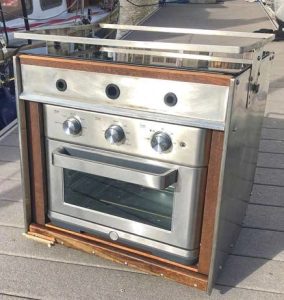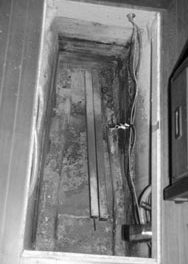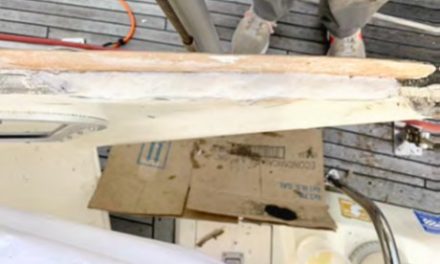A classic plastic gets a modern electric galley.
Issue 155: March/April 2024
As I write this, I am about a day’s sail from American Samoa, bound for Fiji. Triteia, my 1965 Alberg 30, is running wing and wing with following seas about 3 feet high. It is dinnertime, which seems to be the time of day that Neptune decides to increase the rolling of the ship, no matter what seas I find myself sailing in. He must find great entertainment in watching sailors brace themselves and fight to keep their balance as their gimbaled stoves swing with wild abandon.
Since the seas are a bit much at the moment for cooking safely on the range, I have placed a fresh swordfish steak coated in olive oil and seasoned with salt and pepper into my electric air fryer that I retrofitted into my old gimbaled stove. This luxury is the result of a fairly simple but massively rewarding project.
In Honolulu in the spring of 2022, as I was preparing Triteia for cruising, I was faced with the need to upgrade and convert my galley. The galley had always had an alcohol stove, first the original built-in version and later, a gimbaled alcohol stove I installed that was something of a Frankenstein’s monster — a pressurized alcohol stove that had been gutted, with an Origo two-burner stove bolted in place of the original range.

Triteia’s original alcohol stove and oven, removed and ready for conversion.
I had bought the unit cheap at a marine surplus store in Southern California, built an enclosure, and installed it onboard Triteia in 2018. I never minded the alcohol stove and was happy to not have explosive propane gas onboard. But in Honolulu, I was faced with a dilemma; in many places around the world, you simply cannot buy denatured alcohol. I had read this fact time and time again, and it seems the main reason for the prohibition is that denatured alcohol is sometimes consumed as a surrogate alcohol, which can lead to blindness or death.
This left me with two options. I could either convert the galley to propane or upgrade my batteries to lithium and go all electric. Triteia is 30 feet and has very limited stowage, and installing a propane locker would cause me to lose a large amount of space, because I didn’t want to keep the canisters on the aft deck. There was also the cost of buying a new propane stove and all the required hoses and fittings, and I still did not like the idea of having explosive gas onboard. I know there are probably thousands of boats on the water with propane that have never had any explosions, but the few videos I have seen online of boats that did were enough reason for me to not be a fan. I had also read about cruisers having trouble finding fittings to fill their propane tanks as they moved from one country to another.
My only concern about going electric was the cost of lithium batteries and ensuring I could keep them topped up with my limited room for solar panels. In the interest of full disclosure, the decision was made for me when I received a full sponsorship from Dakota Lithium, followed by a sponsorship from Renogy Solar. I installed two new 200Ah lithium batteries, giving me a total of 400Ah. Lithium batteries can be safely taken down to almost 0% without damage to the batteries (not to mention the fact that they maintain 12 volts as they deplete). Then I replaced my two 100-watt solar panels from Renogy with two new 200-watt Renogy panels, giving me a total of 400 watts. With the new system up and running, I was ready to upgrade my galley.

With the old stove and oven parts removed, the shell is prepared for the new appliances.
There are some amazing electric stoves on the market — none of which I could afford. So I opted to retrofit my old alcohol stove into a modern electric induction range and oven. It turned out to be a very simple conversion that I was able to do in a few days after I had all the parts delivered. I went with a two-burner induction range top from Empava and managed to find one that perfectly fit in the top of my old gimbaled stove. Available space was also the determining factor for which convection oven air fryer combo I would use, and I found that the GE Mechanical Air Fryer Toaster Oven combo model with convection mode fit nicely in the space I had to work with. I purchased both appliances on Amazon.
When it was time to start the retrofit project, I was amazed and pleased to find the entire stove was simply bolted together, instead of fastened with rivets as I had expected. I just had to unbolt the stove and discard the oven box and its insulation. Then I cut a large hole out of the thin sheet metal back to allow for ample airflow and fabricated a new bottom out of ¾-inch marine plywood that I coated in epoxy and painted. The wooden bottom helped give the stove some structure that had been lost from removing the rigid oven box.
I then screwed the original metal bottom on top of the new wood base for ease of cleaning and as possible fire protection. The toaster oven has 2 inches of clearance on each side and 1 inch of clearance top and bottom to allow for substantial airflow. I installed rivet nuts on the underside feet of the oven, allowing me to bolt it securely into place.

The complete build, with the new electric stovetop and toaster oven, which has an air fryer and convection cooking mode.
The range was easy to install and sat perfectly in place. I used a hole saw to make several large ventilation holes below it, allowing for better airflow for that unit as well. On the backside of the oven, I mounted a power strip and neatly zip-tied the appliance cords together, covering part of them with a thick rubber hose to prevent any chafe on the back edge of the oven. Once all the appliances were in place, I finished off the build-out with old teak I had been saving, putting teak trim on the face below the range and teak framing around the convection oven to help keep debris out and also make it beautiful. The teak details made the unit look period-appropriate beside Triteia’s dark wood interior.
I then wired the appliances to a dedicated 3,000-watt Renogy inverter. This inverter has done an amazing job and only gave me a warning once, when I tried to run both burners and the air fryer at the same time. I have a 2,000-watt Victron MultiPlus inverter for the house bank and decided to also have a dedicated inverter for my galley so that if something happened and it burned out, I would still be able to use my house inverter to power the galley if needed. Since no system is foolproof, I also have a small Jetboil propane camping stove with a few small canisters as backups, should something happen to my electric galley or electrical system.
I have been using the electric galley for over eight months and have logged more than 4,000 miles under the keel. In all that time, I have never had to limit my cooking due to lack of power. The lowest my batteries have gotten down to is 25%, after riding out a week of thunderstorms. I was prepared to break out my small generator, but the sun finally came out, and after three days of sunshine on the solar panels and a four-hour motorsail, the batteries were back up to 85%.

Bagels anyone?
Converting to lithium and an electric galley was one of the best upgrades I have done to Triteia in the years I have owned her. With the electric galley, I am able to use an electric kettle for my morning coffee and plan to buy a bread maker as well. These are all appliances that would not be possible to use with lead acid batteries without also running a genset.
It feels great to use all renewable energy, and the fact that I never have to track down cooking fuel feels even better. If you are looking to upgrade your galley or electrical system, I highly recommend looking into lithium batteries and an all-electric galley.
James Frederick is currently circumnavigating on board his 1965 Alberg 30 sloop, SV Triteia. After years of adventure sailing in Southern California and then Hawaii, he untied the lines for good and pushed off to see the world. You can see videos of his galley install, lithium conversion, and solar upgrades at his YouTube channel, Sailing Triteia.
Thank you to Sailrite Enterprises, Inc., for providing free access to back issues of Good Old Boat through intellectual property rights. Sailrite.com





